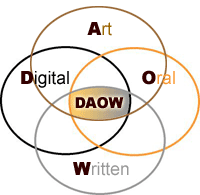Our first project will be a Digital Story, Using still photographs and focusing on your personal object.
Digital Storytelling is the practice of using computer-based tools to tell stories. As with traditional storytelling, most digital stories focus on a specific topic and contain a particular point of view. However, as the name implies, digital stories usually contain some mixture of computer-based images, text, recorded audio narration, video clips and/or music. Digital stories can vary in length, but most of the stories used in education typically last between two and ten minutes. –University of Houston
Some examples of Digital Stories:
Love Letter – a digital story by Stina French
It’s all in a Name – a digital story by Saashley
More Information from Jason Ohler’s (Digital Storytelling expert) website:
The DAOW of literacy in a storytelling environment
Digital, Art, Oral and Written literacies- the DAOW of literacy –  are crucial for personal, academic and workplace success in the Digital Age and blend very well in a digital storytelling environment. .
are crucial for personal, academic and workplace success in the Digital Age and blend very well in a digital storytelling environment. .
Why is oral storytelling important in digital storytelling?
- Because it is how storytelling began and has endured for millennia. It has a history rich in timeless skills, perspective and sense of audience. Good teaching is often a matter of good storytelling. No matter how high tech we become, telling stories to each other orally will endure as one of our primary and most powerful forms of communication. It will always be an important skill to have in the workplace, in our communities and in our schools.
- Because it provides a skill set that can be used alone, as well as transferred to the digital storytelling format. Whether you’re no tech, low tech or high tech, it informs your digital storytelling practices.
-
I know only one thing about the technologies that await us in the future: We will find ways to tell stories with them.
Because video material of people telling oral stories will become increasingly important in digital storytelling. Video material has largely been excluded due to expense and complexity, but this is changing rapidly as digital video gets less expensive and easier to use. Video will present opportunities as well as challenges. The current de facto format for digital storytelling consists of still images with voice-over narration. This format is a relatively flexible, powerful, reflective approach to story creation. As video enters the digital storytelling arena we need to make sure we don’t lose these qualities.
- Because more and more students will tell stories with media accompaniment. Delivering a PowerPoint presentation is a good case in point. The average audience now expects a blend of media and oral presentation. Therefore, let’s spend some of our educational energy focusing on oral presentation to help them be successful.
Why is writing important in digital storytelling?
- Because while writing may not be the final product of a digital story, it is the pathway students must take to create it.Writing is the primary tool used to plan and create a digital story. The saying “if it ain’t on the page then it ain’t on the stage” is just as true for digital storytelling as it is for theater and movies. In fact, media production is a great way to engage kids in writing in an authentic way. Anecdotally, I have heard from teachers that students who don’t want to write school reports are happy to write video plans and scripts because it is not perceived as “school work.” Bottom line: No matter how sophisticated our technology becomes, the future of digital storytelling will involve writing and conventional forms of literacy.
- Because the writing skills that students employ in the process of creating their digital stories embrace many aspects of writing that are valued in school and the workplace.Digital stories compel students to synthesize creative writing and personal reflection with clarity and organization. In the case of academic digital stories, writing is used to plan, script and create a story that demonstrates content area understanding.
Why is art important in digital storytelling?
- Because in a world in which students are required to create websites, digital stories and other forms of new media as part of their school work, art is becoming the next literacy, or 4th R. Thanks to our struggle to use multimedia effectively, the language of art is taking center stage.
- Because digital stories are essentially multimedia art projects, shaped by story.
- Because no matter what technologies await us in the future, we will try to tell stories with them, and to do so we will need to understand design – the grammar of art.
Why is digital literacy important?
The “D” in the DOAW of literacy stands for Digital. Our goal with digital literacy is to use technology “effectively, creatively and wisely.” That is, we want our students to:
- effectivness – to master technological skills
- creativity – to use technology as an imagination amplifier
- wisdom – to see and evaluate technology and its impacts within the larger context of community.